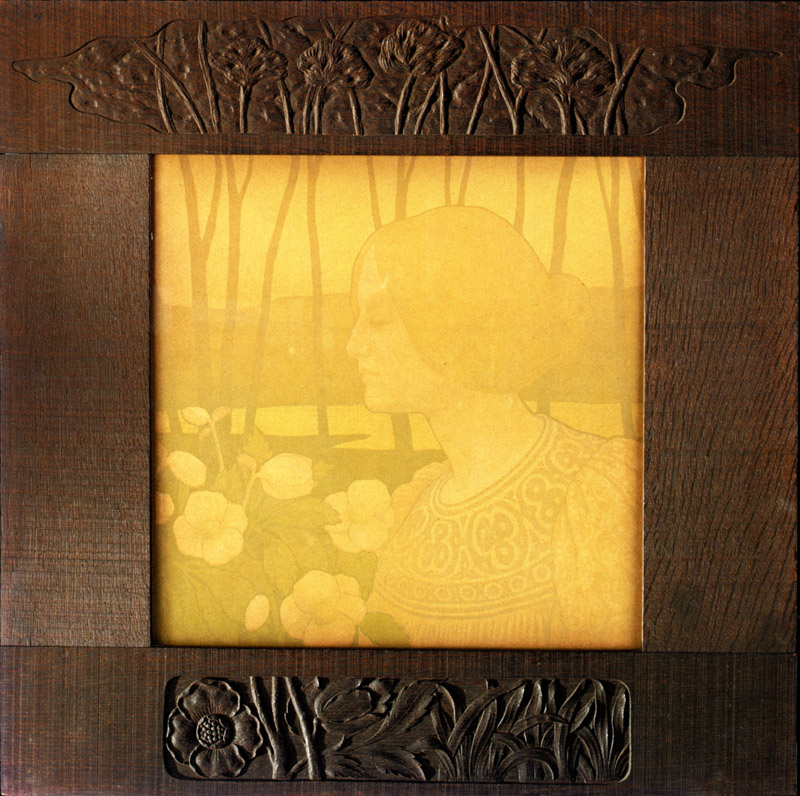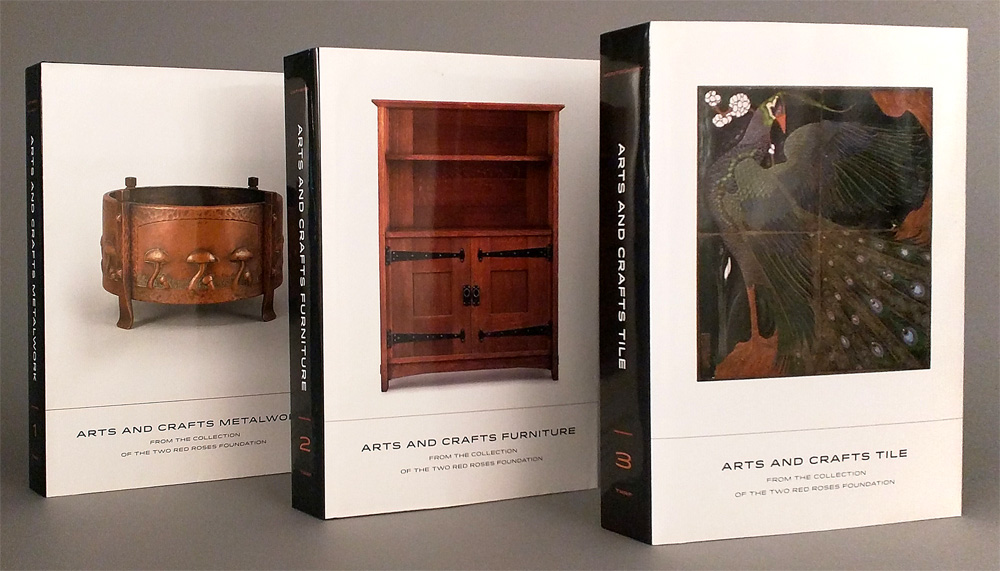Newsletter

Frame, Workshop of Charles Rohlfs, 1902, 26 in. by 26 in., oak, lithograph by Paul Berthon, 1899.
Frames for paintings, prints, and other works are part of a centuries-long tradition of attaching a craft to the traditions of fine art. While the idea of noteworthy frame might to some bring to mind a lavishly ornamented gilt and gesso rococo fantasy paired with an 18th century painting, in every era much attention was given to finish and style in what might suggest a suitable pairing – with varying preferences both by artist and consumer. The Arts & Crafts movement was no different in this regard, but often, in part because of the convictions of its proponents in the alliance of fine art to craft, the union between painting and frame became even more inseparable than ever before.
In the waning years of the 19th century, progressive design movements and the influence of fashionable trends for Japanese and Dutch art helped encourage a new body of frame designs that were alternately novel or historic, yet often relied upon a common simplification of form and decoration, linear and geometric patterns, and importantly, although somewhat rarely, a unification of the subject of the painting with the frame that would envelope it. James Abbott McNeill Whistler, Paul Gauguin, Charles Prendergast, Max Kuehne, Stanford White and many other European and American artists and designers created frames with painted or carved details that would serve as a complement to their own paintings or those of others. While frames had always been a key component of the presentation of an entire painting or print, the opportunity for the artist and craftsperson to continue a subject into this boundary, effectively breaking out of the plane of the picture to form an integrated, sculptural whole, proved irresistible for some.
Most American frames in the Arts and Crafts mode relied upon the effect of a traditional and independent border, typically rendered in flat wood components with broad reveals and wide liners or mats. Stained oak and muted colors dominated and gilding, where used, was often in a dull, satin effect with carving that was simplified or otherwise stylized and confined to repetitions of pattern and line or compartmentalized embellishments. Such a description oversimplifies the wide variety of frames produced in America during the first years of the 20th century – the tastes of artists and purchasers continued to be equally varied in their preferences for a modern or historic style companion frame. Although Arts and Crafts frames may have been in the spirit of progressive design of the era advocating the unification of the arts, among the rarest and most special frames would be those made especially for a single picture.
One such frame in the collection of the Foundation was made in 1902 by Buffalo furniture maker Charles Rohlfs (1853-1936) for use in his own home. Epitomizing both the self-made, individualistic craftsman ideal and Arts and Crafts encouragements to “Do It Yourself,” Rohlfs furnishings for his home involved everything from tables and chairs to sconces, cabinets and various accessories. Several frames were featured within, ranging from simply sawn plank designs to those bearing his signature style of curvilinear forms as carved decoration. For sale he also offered at least two patriotic frame designs, one of which was dominated by a carved eagle, dubbed the “Statesmen” and advertised as sold complete “with picture” – a print of Gilbert Stuart’s unfinished Athenaeum portrait of George Washington.
While these thematic frames are sympathetic with the presidential subject of their accompanying pictures, the Foundation’s unique frame is made all the more exceptional by both its personal association with Rohlfs and the extreme care he lavished upon creating a clear homage to the original lithograph print it still holds today – Roses de Noël (“The Christmas Roses”) by French artist Paul Berthon (1872-1909). Berthon, a student of the École Normale d'Enseignement du Dessin and of the artist Eugène Grasset (1841-1917), remains known largely for his Art Nouveau prints produced at the turn of the century. Here the profile of a woman accompanied by the titular Christmas roses (Helleborus niger) is set against a tree line with rolling hills and water in the background. These so-called roses, actually poisonous hellebores, bear white or pink flowers during the winter months and are associated with the holiday by both the symbolism of the rose and seasonal timing of their blooms.
The frame Rohlfs created for his prized print directly complements and continues these motifs into the wood. Exquisitely carved flowers and foliage appear within the frame’s top and bottom borders, seeming as if they have been revealed by the carver’s chisel just hidden behind the rough sawn adjacent surfaces. The attention to detail is striking – Rohlfs even continues the precise lines of the branches from the edges of the print into his carving. While these highly refined elements appear unlike the sinuous Art Nouveau stylings characteristic of much of his work, the subtle notes of fluid lines remains in the cloud-like framing of the carved tree branches at the top of the frame. The contrast of the rustic, roughly cut plain oak areas with the vaguely Asian-influenced carved decorations imbues this frame with a powerful visual frisson that further marks it as among his most compelling works and a triumph of Arts and Crafts design.
The Foundation’s collections include several other major works by Rohlfs as well as numerous frames by Stanford White, Newcomb-Macklin, Foster Brothers, Carrig-Rohane, Badura, Kuehne, Loeser & Co., Charles Prendergast, and others. We hope you will take a second look the next time you see a painting or print and consider how its frame can be both a window onto an artist’s world and also a work of art and craft in its own right.
-Kevin W. Tucker
For Further Reading:
Joseph Cunningham, The Artistic Furniture of Charles Rohlfs. Exh. cat. New York: American Decorative Art 1900 Foundation; New Haven: Yale University Press, 2008. See p. 251 for an image of the “Statesmen” frame.
Eli Wilner, The Gilded Edge: The Art of the Frame. San Francisco: Chronicle Books, 2000.
Exhibited: Arthur Welsey Dow American Arts and Crafts, The American Federation of Arts, New York, July 13, 1999 - October 1, 2000
Illustrated: Nancy E. Green and Jessie Poesch, Arthur Welsey Dow American Arts and Crafts, New York, 1999, p. 192
The Endless Possibilities:
Arts and Crafts Tiles from the Two Red Roses Foundation
by Dr. Susan Montgomery

In this book, the Two Red Roses Foundation demonstrates its commitment to provide a historic and scholarly record of tiles and architectural faience from its collection. Author Dr. Susan Montgomery explores in great detail the works of sixteen of the most prominent tile makers of the Arts and Crafts movement and more than 165 objects from the TRRF’s collection. Order from our online store. $75.00, free shipping. Please allow approximately 2 weeks for delivery.